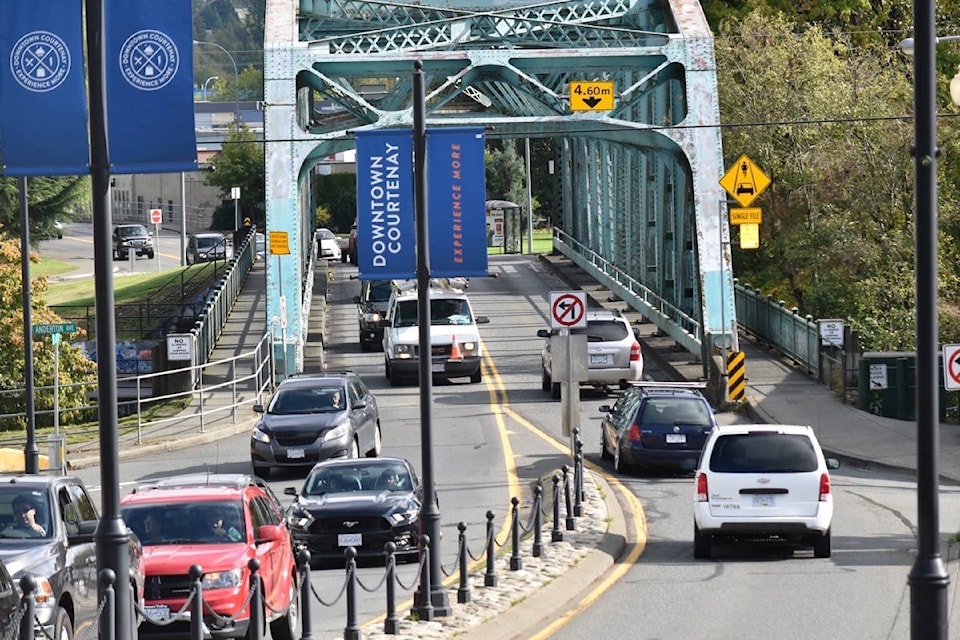In a 5-2 vote Monday, Courtenay council opted not to include cantilevers in the final design of the 5th Street Bridge Rehabilitation Project.
Couns. David Frisch and Melanie McCollum were the lone members in favour of cantilevers, which have not been a popular option with downtown business owners.
READ: Business owners blast council…
Last year when initially presented with the cantilever option, Doug Hillian and Manno Theos were the only councillors to oppose the idea. They favoured a recommended $6.3 million to recoat and renew the bridge deck, and to explore options for a 6th Street pedestrian/bike bridge.
The three-metre wide cantilevers were intended to provide more space and to prevent cyclists from sharing the road with vehicles. They would have added about $2 million to the repair bill, and two months to a six-month construction period.
Hillian notes significant opposition from downtown, which he considers a “primary constituency” in the rehab project. He suggests a 6th Street crossing would be difficult to complete if council takes on the additional debt that cantilevers entail.
“I don’t see the cantilever option as giving us the significant traffic improvements we’re looking for, particularly with regards to cycling,” Hillian said. “I don’t see cyclists dismounting to access whatever lane configuration is needed to get into the cantilevers.”
He thinks confident cyclists will continue to ride across the bridge.
Coun. Wendy Morin had hoped that adding cantilevers would improve crossings for non-vehicle traffic, but changed her mind after hearing from consultants about difficulties in terms of getting on and off the bridge.
“It seems like the limitations don’t meet the needs we had hoped for,” Morin said. “I think we have the opportunity to meet the needs of more residents by focusing on the 6th Street option…I think the investment we make in 6th Street will get more bang for our buck in a variety of ways.”
Frisch said cantilevers would be “significantly less” than a new pedestrian bridge, which consultants say would exceed $3 million. He struggles to see a 6th Street crossing happening by 2022, as suggested by City staff.
“If we save the money by going with the cantilevers now, we’ll have more money to put into our Cycling Network Plan, sooner rather than later,” Frisch said.
Will Cole-Hamilton reminded council that the Downtown Courtenay Business Improvement Association made it clear that an extended construction time would place an increased burden on businesses, and would be detrimental to the health of downtown.
“Given the new information before us, and the feedback I’ve received, I believe the 6th Street option best meets the needs of our community, and meets them better than the cantilever option on Fifth,” he said. “From the perspective of future users, I see the connectivity of the 6th Street option as superior, allowing free access from the north or south at each end, and allowing cyclists immediate and direct access to the 6th Street Cycling Corridor on the west side. In contrast, the connectivity on the 5th Street option, particularly on the west side, will be challenging to many users.”
A 6th Street option, he added, would connect the trail system from the Lewis Centre south to the far end of the Riverway Trail.
“I think a connection to Simms Park will be used extensively,” Hillian added.
While 6th Street is likely to provide a better crossing for cyclists, McCollum said that factor in and of itself doesn’t outweigh other concerns.
“I truly think that pedestrians will still be favoring a 5th Street crossing, with a 6th Street one there,” McCollum said. “Just knowing how easy it is to make a small detour on a bike. Generally, if you’re walking, you’re not going to detour two blocks just to use a separate bridge.”
She is concerned about the amount of money, and time, that might be spent on a 6th Street crossing. She also notes the Transportation Master Plan points to the 5th crossing as the higher priority multi-use to cross river, while 6th did not receive the same priority.
“To me, there are still a lot of questions to be answered,” McCollum said. “Are we comfortable choosing an option that could potentially double the cost of putting in a safe crossing?”
Theos thinks painting and resurfacing will make a great impact on the appearance of the bridge. Conversely, he has trouble making sense of spending $2 million for an addition (cantilevers) to the 60-year-old bridge.
“It’s just not safe for cyclists accessing and leaving that bridge,” Theos said. “It’s a high-traffic area, and finding relief for cyclists is critical, and that to me was never the answer putting cantilevers on the bridge.”
Mayor Bob Wells said the 6th Street crossing appears to have become a popular option in the eyes of the public, compared to five or 10 years ago.
The City will receive $1.96 million in federal funding that requires rehabilitation of the bridge by March 31, 2022. Construction is planned for 2021. Traffic would be single-lane alternating during construction.
An alternate approval process will be used to acquire voter assent for the money needed to upgrade the bridge.
Project updates are available at www.courtenay.ca/fifthstreetbridge.
reporter@comoxvalleyrecord.com
Like us on Facebook and follow us on Twitter
